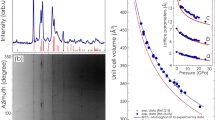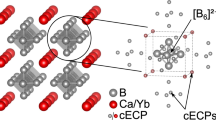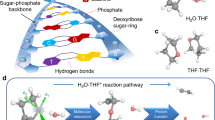Abstract
Alkane molecules are held together in the crystal state by purportedly weak homonuclear R–H···H–R dihydrogen interactions. In an apparent contradiction, the high melting points and vaporization enthalpies of polyhedranes in condensed phases require quite strong intermolecular interactions. Two questions arise: ‘How strong can a weak C–H···H–C bond be?’ and ‘How do the size and topology of the carbon skeleton affect these bonding interactions?’ A systematic computational study of intermolecular interactions in dimers of n-alkanes and polyhedranes, such as tetrahedrane, cubane, octahedrane or dodecahedrane, showed that attractive C–H···H–C interactions are stronger than usually thought. We identified factors that account for the strength of these interactions, including the tertiary nature of the carbon atoms and their low pyramidality. An alkane with a bowl shape was designed in the search for stronger dihydrogen intermolecular bonding, and a dissociation energy as high as 12 kJ mol−1 is predicted by our calculations.
This is a preview of subscription content, access via your institution
Access options
Subscribe to this journal
Receive 12 print issues and online access
$259.00 per year
only $21.58 per issue
Buy this article
- Purchase on Springer Link
- Instant access to full article PDF
Prices may be subject to local taxes which are calculated during checkout




Similar content being viewed by others
References
Nishio, M. CH/π hydrogen bonds in crystals. CrystEngComm 6, 130–158 (2004).
Janiak, C. A critical account on π–π stacking in metal complexes with aromatic nitrogen-containing ligands. Dalton Trans. 3885–3896 (2000).
Metrangolo, P., Meyer, F., Pilati, T., Resnati, G. & Terraneo, G. Halogen bonding in supramolecular chemistry. Angew. Chem. Int. Ed. 47, 6114–6127 (2008).
Metrangolo, P. & Resnati, G. Halogen Bonding: Fundamentals and Applications (Springer, 2008).
Risannen, K. Halogen bonded supramolecular complexes and networks. CrystEngComm. 10, 1107–1113 (2008).
Politzer, P., Lane, P., Concha, M. C., Ma, Y. & Murray, J. S. An overview of halogen bonding. J. Mol. Model. 13, 305–311 (2007).
Metrangolo, P., Neukirch, H., Pilati, T. & Resnati, G. Halogen bonding based recognition processes: a world parallel to hydrogen bonding. Acc. Chem. Res. 38, 386–395 (2005).
Subramanian, S. & Zaworotko, M. J. Exploitation of the hydrogen bond: recent developments in the context of crystal engineering. Coord. Chem. Rev. 137, 357–401 (1994).
Desiraju, G. R. Hydrogen bonds and other intermolecular interactions in organometallic crystals. Dalton Trans. 3745–3751 (2000).
Desiraju, G. R. & Steiner, T. The Weak Hydrogen Bond in Structural Chemistry and Biology (Oxford Univ. Press, 1999).
Crabtree, R. H. A new type of hydrogen bond. Science 282, 2000–2001 (1998).
Custelcean, R. & Jackson, J. E. Dihydrogen bonding: structures, energetics, and dynamics. Chem. Rev. 101, 1963–1980 (2001).
Richardson, T. B., de Gala, S., Crabtree, R. H. & Siegbahn, P. E. M. Unconventional hydrogen bonds: intermolecular B–H···H–N interactions. J. Am. Chem. Soc. 117, 12875–12876 (1995).
Calhorda, M. J. Weak hydrogen bonds: theoretical studies. Chem. Commun. 801–809 (2000).
Braga, D., De Leonardis, P., Grepioni, F., Tedesco, E. & Calhorda, M. J. Structural and theoretical analysis of M–H···H–M and M–H···H–C intermolecular interactions. Inorg. Chem. 37, 3337–3348 (1998).
Novoa, J. J. & Whangbo, M.-H. Interactions energies associated with short intermolecular contacts of C–H bonds. II: Ab initio computational study of the C–H···H–C interactions in methane dimer. J. Chem. Phys. 94, 4835–4841 (1991).
Tsuzuki, S., Honda, K., Tadafumi, U. & Mikami, M. Magnitude of interaction between n-alkane chains and its anisotropy: high-level ab initio calculations of n-butane, n-pentane and n-hexane dimers. J. Phys. Chem. A 108, 10311–10316 (2004).
Rossini, F. D., Pitzer, K. S., Arnett, R. L., Braun, R. M. & Pimentel, G. C. Selected Values of Physical and Thermodynamic Properties of Hydrocarbons and Related Compounds (Carnegie, 1952).
Chickos, J. S. & Hanshaw, W. Vapor pressures and vaporization enthalpies for the n-alkanes from C31 to C38 at T=298.15 K by correlation gas chromatography. J. Chem. Eng. Data 49, 620–630 (2004).
Tsuzuki, S. & Lüthi, H. P. Interaction energies of van der Waals and hydrogen bonded systems calculated using density functional theory: assessing the PW91 model. J. Chem. Phys. 114, 3949–3957 (2001).
Li, A. H. T. & Chao, S. D. Intermolecular potentials of the methane dimer calculated with Møller–Plesset perturbation theory and density functional theory. J. Chem. Phys. 125, 094312 (2006).
Prokhvatilov, A. I. & Isakina, A. P. An X-ray powder diffraction study of crystalline α-methane-d4 . Acta Crystallogr. B 36, 1576–1580 (1980).
Lide, D. R. Handbook of Chemistry and Physics (CRC, 2003).
Maier, G. et al. Tetrakis(trimethylsilyl)tetrahedrane. J. Am. Chem. Soc. 124, 13819–13826 (2002).
Tanaka, M. & Sekiguchi, A. Hexakis(trimethylsilyl)tetrahedranyltetrahedrane. Angew. Chem. Int. Ed. 44, 5821–5823 (2005).
Imgartinger, H. et al. Tetra-tert-butyltetrahedrane – crystal and molecular structure. Angew. Chem. Int. Ed. 23, 993–994 (1984).
Sekiguchi, A. & Tanaka, M. Tetrahedranyllithium: synthesis, characterization, and reactivity. J. Am. Chem. Soc. 125, 12684–12685 (2003).
Amoreux, J. P. & Foulon, M. Comparison between structural analyses of plastic and brittle crystals. Acta Crystallogr. B 43, 470–479 (1987).
Lee, C.-H., Liang, S., Haumann, T., Boese, R. & de Meijere, A. p-[32.56]Octahedrane, the (CH)12 hydrocarbon with D3d symmetry. Angew. Chem. Int. Ed. 32, 559–561 (1993).
Fleischer, E. B. X-ray structure determination of cubane. J. Am. Chem. Soc. 86, 3889–3890 (1964).
Bertau, M. et al. From pagodanes to dodecahedranes – search for a serviceable access to the parent (C20H20) hydrocarbon. Tetrahedron 53, 10029–10040 (1997).
Gallucci, J. C., Doecke, C. W. & Paquette, L. A. X-ray structure analysis of the pentagonal dodecahedrane hydrocarbon (CH)20 . J. Am. Chem. Soc. 108, 1343–1344 (1986).
Echeverría, J., Casanova, D., Llunell, M., Alemany, P. & Alvarez, S. Molecules and crystals with both icosahedral and cubic symmetry. Chem. Commun. 2717–2725 (2008).
Wolstenholme, D. J. & Cameron, T. S. Comparative study of weak interactions in molecular crystals: H–H bonds vs hydrogen bonds. J. Phys. Chem. A 110, 8970–8978 (2006).
Robertson, K. N., Knop, O. & Cameron, T. S. C–H···H–C interactions in organoammonium tetraphenylborates: another look at dihydrogen bonds. Can. J. Chem. 81, 727–743 (2003).
Grabowski, S. J., Pfitzner, A., Zabel, M., Dubis, A. T. & Palusiak, M. Intramolecular H···H interactions for the crystal structures of [4-((E)-but-1-enyl)-2,6-dimethoxyphenyl]pyridine-3-carboxylate and [4-((E)-pent-1-enyl)-2,6-dimethoxyphenyl]pyridine-3-carboxylate; DFT calculations on modeled styrene derivatives. J. Phys. Chem. B 108, 1831–1837 (2004).
Matta, C. F., Hernández-Trujillo, J., Tang, T.-H. & Bader, R. F. W. Hydrogen–hydrogen bonding: a stabilizing interaction in molecules and crystals. Chem. Eur. J. 9, 1940–1951 (2003).
Bartell, L. S. On the effects of intramolecular van der Waals forces. J. Chem. Phys. 32, 827–831 (1960).
Alkorta, I., Elguero, J. & Foces-Foces, C. Dihydrogen bonds (A–H···H–B). Chem. Commun. 1633–1634 (1996).
Bader, R. F. W. Atoms in Molecules. A Quantum Theory (Oxford Univ. Press, 1990).
Rzepa, H. S. & Allan, C. S. M. Racemization of isobornyl chloride via carbocations: a nonclassical look at a classic mechanism. J. Chem. Educ. 87, 221–228 (2010).
Castillo, N., Matta, C. F. & Boyd, R. J. The first example of a cage critical point in a single ring: a novel twisted α-helical ring topology. Chem. Phys. Lett. 409, 265–269 (2005).
Bader, R. F. W. Bond paths are not chemical bonds. J. Phys. Chem. A 113, 10391–10396 (2009).
Dunitz, J. D. & Gavezzotti, A. How molecules stick together in organic crystals: weak intermolecular interactions. Chem. Soc. Rev. 38, 2622–2633 (2009).
Alvarez, S. & Echeverría, J. New perspectives on polyhedral molecules and their crystal structures. J. Phys. Org. Chem. 23, 1080–1087 (2010).
Petrukhina, M. A. & Scott, L. T. Coordination chemistry of buckybowls: from corannulene to a hemifullerene. Dalton Trans. 2969–2975 (2005).
Frisch, M. J. et al. Gaussian03 (Revision D.02) (Gaussian, Wallingford, Connecticut, USA, 2004).
Werner, H.-J. et al. MOLPRO, a package of ab initio programs, version 2009.1 (Molpro, 2009).
Keith, T. A. AIMAll version 10.12.08 (AIMAll, 2010).
Ortiz, J. C. & Bo, C. XAIM (Universitat Rovira i Virgili, Tarragona, Spain, 1998).
Acknowledgements
This work was supported by the Ministerio de Investigación, Ciencia e Innovación (MICINN, project CTQ2008-06670-C02-01-BQU), Generalitat de Catalunya (grants 2009SGR-1459 and XRQTC) and the Israel Science Foundation (ISF Grant 53/09). Allocation of computer time at the Centre de Supercomputació de Catalunya is acknowledged. The authors thank A. Lledós, R. Hoffmann, S. Olivella, P. Alemany, E. Ruiz and H. Rzepa for discussions and suggestions.
Author information
Authors and Affiliations
Contributions
J.E. carried out literature searches of related computational and experimental work, performed geometry optimizations and electron-density analysis of the dimers of open-chain alkanes, small polyhedranes and the buckybowlane, and participated in the preparation of graphic material for the manuscript. G.A. performed the geometry optimizations and electron-density analyses of the dimers of large polyhedranes. D.D. carried out benchmark calculations to help select the most adequate computational methodology. S.S. designed the benchmark and exploratory calculations. S.A. conceived the project, helped design the computational goals and strategies and wrote the manuscript. All authors actively participated in the discussion of the results and in the design of new computational experiments, and made contributions to the manuscript.
Corresponding authors
Ethics declarations
Competing interests
The authors declare no competing financial interests.
Supplementary information
Supplementary information
Supplementary information (PDF 355 kb)
Rights and permissions
About this article
Cite this article
Echeverría, J., Aullón, G., Danovich, D. et al. Dihydrogen contacts in alkanes are subtle but not faint. Nature Chem 3, 323–330 (2011). https://doi.org/10.1038/nchem.1004
Received:
Accepted:
Published:
Issue Date:
DOI: https://doi.org/10.1038/nchem.1004
This article is cited by
-
The roles of charge transfer and polarization in non-covalent interactions: a perspective from ab initio valence bond methods
Journal of Molecular Modeling (2022)
-
Porous metal-metalloporphyrin gel as catalytic binding pocket for highly efficient synergistic catalysis
Nature Communications (2019)
-
London dispersion forces in sterically crowded inorganic and organometallic molecules
Nature Reviews Chemistry (2017)
-
Study of Alcohol and Aldehydes Interaction on the Surface of Silicane Nanosheet: Application of Density Functional Theory
Journal of Inorganic and Organometallic Polymers and Materials (2017)
-
Formation of β-cyclodextrin complexes in an anhydrous environment
Journal of Molecular Modeling (2016)



